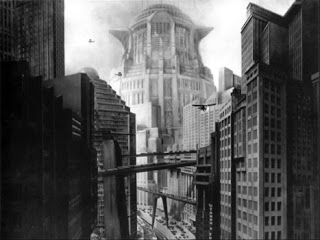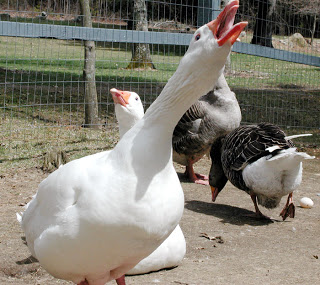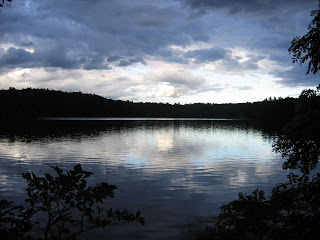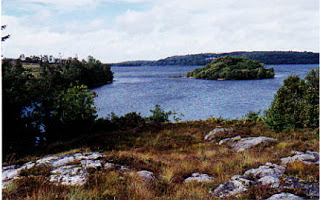The effect of real and imagined landscapes
I read an interesting article recently in the Boston Globe by Jonah Lehrer, in which the author explores recent studies into how living in cities can hurt your brain. I forwarded it to my Best Beloved, with “I told you so” in the subject line.
In Lehrer’s article, he acknowledges that cities have historically been viewed as “the engine of intellectual life,” but goes on to say:
“Now scientists have begun to examine how the city affects the brain, and the results are chastening. Just being in an urban environment, they have found, impairs our basic mental processes. After spending a few minutes on a crowded city street, the brain is less able to hold things in memory, and suffers from reduced self-control. While it’s long been recognized that city life is exhausting — that’s why Picasso left Paris — this new research suggests that cities actually dull our thinking, sometimes dramatically so.
“‘The mind is a limited machine,’says Marc Berman, a psychologist at the University of Michigan and lead author of a new study that measured the cognitive deficits caused by a short urban walk. ‘And we’re beginning to understand the different ways that a city can exceed those limitations.'”
Metropolis — Fritz Lang
It’s apparently a problem of too much stimuli and of the pace of that stimuli. Nature is, of course, rich, diverse, teeming with life both tiny and humongous, but the pace is slower, more attuned to the ability of our minds to function properly.
After living in Paris for five years and trying to write a book amid the incessant car horns and construction noise (Parisians are FOREVER RENOVATING), garbage and glass-shattering recycling trucks, the chattering, foot-clomping, flushing, burping, pot-clanging, bass beating, toddler whining, noise blowing, vacuum cleaning of the people living above and below us, not to mention the endless vocal exercises of the opera singer of questionable talent, I can well attest to the psychologically detrimental effects of urban noise, and that’s just one aspect of the problem. I haven’t even touched on pollution, and conflicting, overwhelming, visual stimuli, even if, as in Paris, there are any number of almost absurdly pretty things to look at.
In fact, in the last couple of years of our French sojourn, I was such a nervous wreck, so desperately in need of nature’s balm, that we rented a house, built in 1752, in the farmland of Normandy where I set up temporary residence. The house was small, and surrounded by a huge high fence with gates you drove through and had two barns and several sheds, including an old bread-oven scattered around the property amidst a sadly neglected orchard and meadow. Our neighbors were Micheline and Andre, farmers who kept sheep and rabbits and geese and a lovely mutt named Fidel, and I walked every day down the road to visit a donkey named Gamin (which means street-urchin, or waif), who came to the sound of my voice like a dog, possibly because I always brought carrots and apples.
Now, I can hear many of you complaining that they could NEVER write in the boring old country, that it’s for old farts, and without the hustle and flow, the glimmer and jazz of city life, the art and music, the very thrum of teeming humanity, their creative juices would dry to dust.
Quite right, err, write. But not for me. Within a few days of moving out of the city I was writing again, and sleeping again, and not bursting into tears in the middle of the day and not jumping out of my skin at every crash and bump above or below. I found the honking of geese infinitely preferable to that of cars.
After moving to the United States a few years ago, My Best Beloved and I now live in a lovely quiet house on a couple of acres of wooded land. (Well, it’s quiet except for one or two loathsome neighborhood dogs — actually, the dogs are quite nice, but the owners haven’t a clue — and the seasonal aggravation of leaf-blowers, industrial lawn mowers, and the occasionally badly behaved children.) I tell my Best Beloved that two acres is good, twenty is better, and two hundred would be paradise. A girl can dream.
As Henry David Thoreau said,
“We need the tonic of the wilderness, to wade sometimes in marshes where the bittern and meadow-hen lurk, and hear the booming of the snipe; to smell the whispering sedge where only some wilder and more solitary fowl
builds her nest and the mink crawls with its belly close to the ground.”
I’m also reading a lovely book by one of my favorite authors, Chet Raymo, called “Climbing Brandon.” Raymo, who lives part of each year on the Dingle peninsula in Ireland guides us up Brandon’s sacred mountain, weaving a brilliant mix of folklore and natural history, spiritual and physical geographies. It is through the land that we are introduced to great heroes and saints, as well as meditations on “the drifting continents, grinding glaciers, globe-spanning ocean currents…” He also tells, through the landscape, the story of the Irish conversion to Christianity, in a form that was unique in Europe, in that it was profoundly and intensely intellectual while at the same time rooted in the natural world – a wonderful fusion of wisdom and mystery. It’s a delight to see how the earth, sea, sky, and all the creatures therein inspire Raymo, and a real pleasure to be guided by him.
As a writer so deeply influenced by the landscape myself, I am at the moment struggling to bring my own sense of wonder and majesty to the novel I’m writing set in the Cheviot Hills and the north-east coast of Britain in the 7th c. I have no idea at this point whether I shall succeed in honoring a
place I find haunting, inspiring, nourishing and humbling, but I’m trying, and in the trying, I find I am creating a sort of mythical landscape, similar to but not entirely identical to the landscape that actually exists. That’s what writers do. We take our experience and filter it through our subconscious and mold it to an idea and give birth to something which doesn’t really reflect the facts, although we hope it reflects the truth.
And speaking of mythical landscapes — one of my favorite poems is that of William Butler Yeats — The Lake Isle of Innisfree.
I will arise and go now, and go to Innisfree,
And a small cabin build there, of clay and wattles made;
Nine bean rows will I have there, a hive for the honeybee,
And live alone in the bee-loud glade.
And I shall have some peace there, for peace comes dropping slow,
Dropping from the veils of the morning to where the cricket sings;
There midnight’s all a-glimmer, and noon a purple glow,
And evening full of the linnet’s wings.
I will arise and go now, for always night and day,
I hear the water lapping with low sounds by the shore;
While I stand on the roadway, or on the pavements gray,
I hear it in the deep heart’s core.
Just as when I write about a place and thereby create a landscape not factually existent, in reading Yeats’ poem the “Island of Innisfree” has become a sort of mythological destination of the heart for me, one that, even if I lived on Innisfree, would doubtless still be slightly out of reach, just over the edge of the horizon.
Still, even reading of the bee-loud glad, the linnet’s wings, the midnight all a-glimmer, the water lapping with low sounds, gives me a sense of inner peace, as though by reading it the images come alive in my consciousness, and the Innisfree-in-my-mind exists, real and tangible as the tilting cedar full of cardinals, wrens and chickadees in my garden.
If, as Baha’u’llah, the founder of the Baha’i Faith once said, the city is the home of the body, while the country is the home of the soul, I wonder how to define the land that exists only in our imaginations, but which is no less a place of peace and solace for all its intangibility. They are undeniably powerful, these temenos of memory and imagination, these secret gardens, if you will.
Copyright 2008 Lauren B. Davis For permissions: laurenbdavis.iCopyright.com



